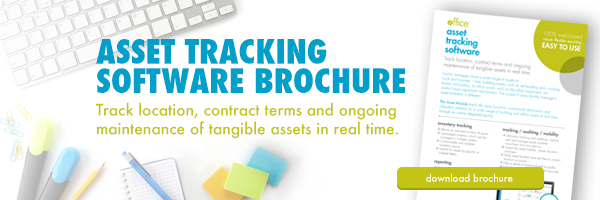3 Good Reasons to Invest in Asset Tracking Software This Year


In the facilities management (FM) world, it can be easy to fall into a routine, especially when it’s the way your company has been doing things for years. But when something unexpected happens in a large organization, the issue isn’t just being tardy – it’s potentially a very costly problem. This is especially true when it comes to asset tracking.
The assets the FM team is in charge of run the gamut. For instance, they need to know the status, location and utilization of every desk, laptop and printer, as well as larger, more expensive equipment.
It doesn’t make sense to try to manage all of a company’s assets manually. Instead, here’s why your business should invest in asset tracking software.
3 Reasons to Invest in Asset Tracking Software
1. Make Smarter Budgeting Decisions
To avoid incorrectly allocating budget and resources, the FM team needs visibility into the status of every asset as well as what assets employees are and aren’t using. They need on-demand access to real-time asset data – something they can’t accomplish if they’re working with hard copies of documents or manually updated spreadsheets. Relying on this system puts the FM team at risk of having multiple versions of the same documents and, as a result, different team members could be basing decisions off conflicting information. In other words, it’s extremely challenging to have an accurate, comprehensive view of the asset portfolio without asset tracking software.
However, with asset tracking software, the facilities management team can be 100 percent confident about an asset’s location without having to actually be in the physical presence of the asset. And if an asset goes missing, they’ll know immediately, instead of being in the dark for days (or even weeks or months.) The FM team will also have insight into the true utilization of any asset, which means they can ensure the company isn’t wasting funds on storing and maintaining equipment it doesn’t actually need.
Additionally, calculating the actual total asset value is more challenging and prone to human error without asset tracking software. If the organization has an incorrect appraisal, it may not know it is better to invest in replacing an older, poor-performing asset than continue spending money on its maintenance.
2. Streamline Maintenance Procedures
When information is spread across several siloed databases and not in a single asset tracking platform, the facilities management team will have to hunt for data in multiple places. While one file may contain the list of required software updates, the asset’s maintenance schedule and calibrations could be in two or three completely different locations. Or, even worse, these details could be contained on a physical document that (obviously) can’t be accessed remotely.
An asset tracking solution, on the other hand, collects all of this information and organizes it into a single database that the facilities management team can easily view and manage. Within the platform, the FM team can search by serial number, owner, location or type and instantly see all of the data for that asset.
Asset tracking software enables the facilities management team to be more efficient when it comes to scheduled maintenance. Rather than depending on a Google spreadsheet, Outlook calendar alert or printed schedule for reminders about scheduled maintenance, the facilities management team can receive automatic alerts when an asset is due for its monthly or annual service. An asset tracking solution helps the FM team reduce the risk of unexpected equipment breakdowns which are costly (and avoidable).
Asset tracking software supports the facilities management team in not only more effectively executing scheduled maintenance but predictive maintenance as well. Commonly known as intelligent maintenance, predictive maintenance uses Internet of Things (IoT) sensors to track the true utilization of an asset. This data is fed into the asset tracking platform to help the facilities management team proactively determine when the asset should be serviced, rather than relying on the manufacturer’s recommended schedule. IoT sensors and asset tracking software allow the FM team to create a personalized maintenance plan that best suits the company’s specific needs.
3. Maintain Compliance with New FASB Accounting Standards
One of the best reasons to invest in an asset tracking solution is that it will be easier to adhere to the new FASB accounting standards. These guidelines require companies to keep more detailed reports than in previous years about all leased assets.
In order to stay compliant, there are five crucial details about every asset the facilities management team needs to be able to quickly access:
- Lease terms, including lease duration and individual rental fees
- Type of lease – i.e., a finance lease or an operating lease
- Maintenance records
- Asset location
- Asset age
Using asset tracking software ensures the FM team can easily locate this information and be confident it is up to date and accurate. Without an asset management platform, the facilities management team may not know for sure which assets must be recorded on the balance sheet – for example, all leases with terms greater than one year must be included. And if the quarterly financial statements the business submits is inaccurate, it will be subject to potentially large fines.
Just like routines, surprises are (most of the time) a good thing. But there’s rarely such a thing as a “happy” surprise when it comes to facilities management. Make sure you’re prepared for anything that’s thrown your way by investing inasset tracking software.
